The heart of London is full of strange old places with unusual names and odd stories, but there is one place that for a very long time was not a true part of London at all. Ely Place, just to the north of Holborn Circus, was until relatively recently considered to be a part of Cambridgeshire. For centuries, it was an enclave – an area of land physically located in the City of London but not under its jurisdiction. Instead, it was privately owned by the Bishops of Ely, and even today the street has its own gatehouse and beadles.
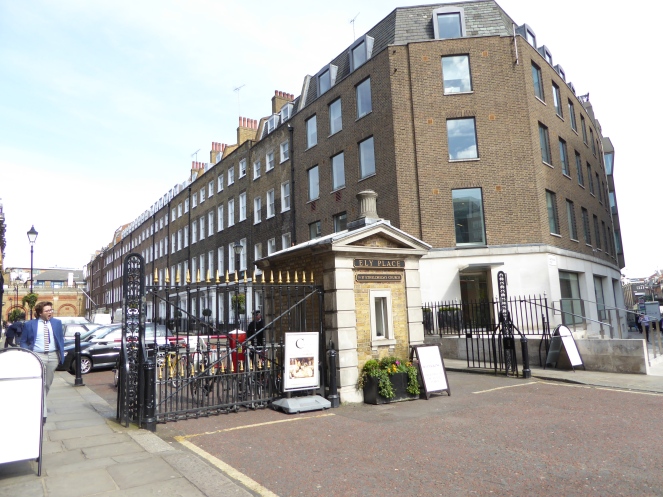
Ely Place was described by Walter Thornbury in 1878 as follows:
To the public it is one of those unsatisfactory streets which lead nowhere; to the inhabitants it is quiet and pleasant; to the student of Old London it is possessed of all the charms which can be given by five centuries of change and the long residence of the great and noble.
There have been many “great and noble” people, to use Thornbury’s turn of phrase, who have made Ely Place their home (or one of their homes) over the centuries. The first powerful residents, the people who gave the street its name, were the Bishops of Ely. In the late 13th Century, John de Kirkby became Bishop of Ely, and as he owned some land to the north of Holborn he established a town house there which became the official London residence of the Bishops of Ely.
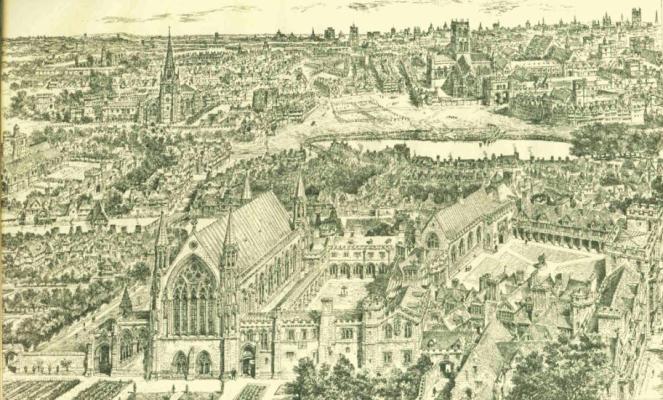
But why would the Bishop of Ely even have a palace in London in the first place? Like many other bishops, the Bishop of Ely had a seat in the House of Lords, and his parliamentary duties meant that he would have spent a part of the year in London. Therefore it made sense to maintain a home in the capital. It was, however, often the case that considerable efforts would be made to ensure that these residences were not subject to the laws and – most importantly – taxes of London. By establishing a site as an enclave, Ely Place was legally a part of the Diocese of Ely, Cambridgeshire despite its London location. A magnificent gatehouse separated the enclave from the London streets beyond. Rev. Stephen Eyre Jarvis, in a 1911 visitor guide written about Ely Place and the church of St Etheldreda, describes the status of the bishops’ residences in London:
In former times most of the Bishops had seats, in or near London, in which they resided during their attendance on Parliament. Within the precincts of these residences they retained their jurisdiction as in their own dioceses. Some of these episcopal residences, with their enclosures, were exempt also from the ordinary civil jurisdiction, so that taxes could not be levied there. Hence they were called Liberties. Ely Place, besides being a Liberty, was also a Sanctuary, where persons pursued by the law for certain offences could not be arrested by the civil authorities. (pp3-4)
A private chapel was built alongside the Bishop’s palace, and it was dedicated to St Etheldreda, the woman who founded the first religious house in Ely in the 7th Century, and the saint to whom Ely Cathedral was dedicated. The chapel dates from the late 13th Century and is one of the only buildings in London surviving from the reign of Edward I. Today, the chapel is the only surviving remnant of the Bishops’ palace – unlike so many City churches, it escaped the flames of the Great Fire in 1666, although it was severely damaged following an air raid during the Second World War.
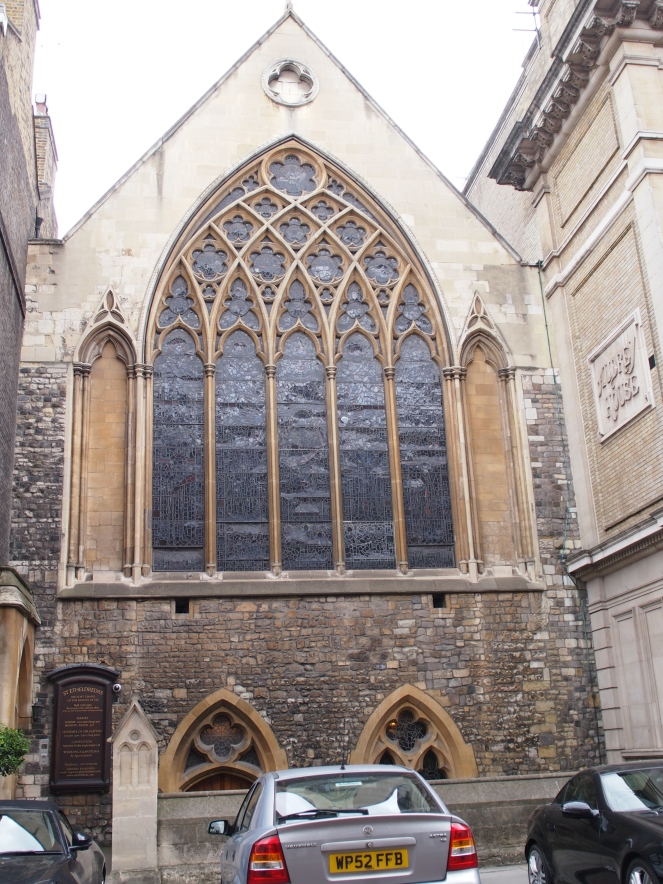
The land owned by the Bishops of Ely extended far beyond modern-day Ely Place, to approximately Leather Lane in the west and Saffron Hill in the east – and in the palace grounds orchards and vineyards were planted. Ely Place became famous for these gardens, particularly the strawberries grown there, which were immortalised in an exchange between the Duke of Gloucester and the Bishop of Ely in Shakespeare’s Richard III:
When I was last in Holborn,
I saw good strawberries in your garden there
I do beseech you send for some of them
Probably the most well-known of Ely Place’s inhabitants was John of Gaunt, Duke of Lancaster and son of King Edward III. John’s vast palace of Savoy on the banks of the Thames was burnt down during the Peasants’ Revolt uprisings in 1381, and after this event John moved to Ely Place and used the Bishops’ palace there as a residence for the rest of his life – he died there in 1399. It’s not known exactly how John of Gaunt was able to secure a move into the palace after the Savoy was destroyed, but it has been speculated that from time to time the Bishops of Ely let it out to wealthy tenants, perhaps as a source of income.
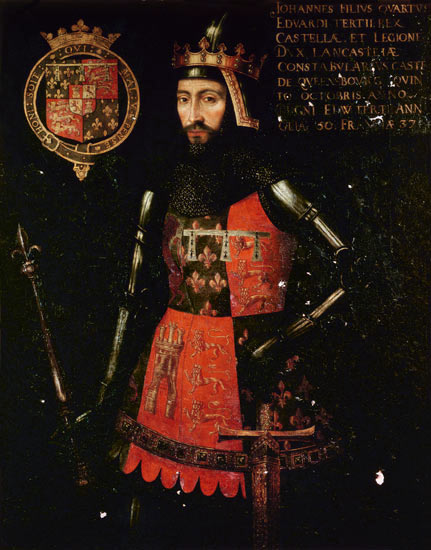
John of Gaunt’s time spent at Ely Place also earned the enclave a place in the work of William Shakespeare; in Richard II, it is while at Ely Place that John of Gaunt utters the famous lines:
This royal throne of kings, this scepter’d isle,
This Earth of majesty, this seat of Mars,
This other Eden, demi-Paradise,
This fortress built by Nature for herself
Against infection and the hand of war,
This blessed plot, this Earth, this realm, this England.
Another famous name associated with Ely Place is Sir Christopher Hatton. Hatton took out a lease on parts of Ely Place in in 1576 – the Bishop of Ely at the time had not been keen to lease him the lands, but pressure from Queen Elizabeth I – Hatton was one of her favourites – forced him to agree terms with Hatton. Hatton built himself a magnificent new residence, Hatton House, on the site. No trace of this building now remains – it was demolished in the 1650s when Hatton’s grandson, another Sir Christopher Hatton, got into financial difficulties and turned the old mansion and its gardens into a number of streets and houses. One of these streets is the present-day Hatton Garden, now famous for its jewel trade.

Through a narrow passage off Ely Place a tiny, hidden pub can be found. Ye Olde Mitre has been in existence since 1546. It was built on the orders of Bishop Thomas Goodrich, the first Bishop of Ely who submitted to the King’s authority over the Church in England after Henry VIII’s Reformation. The current building dates from about the same time as the townhouses that now grace Ely Place itself. Owing to Ely Place’s previous status as an enclave, the pub’s licence was issued by the Cambridge authorities until as recently as the 1960s.
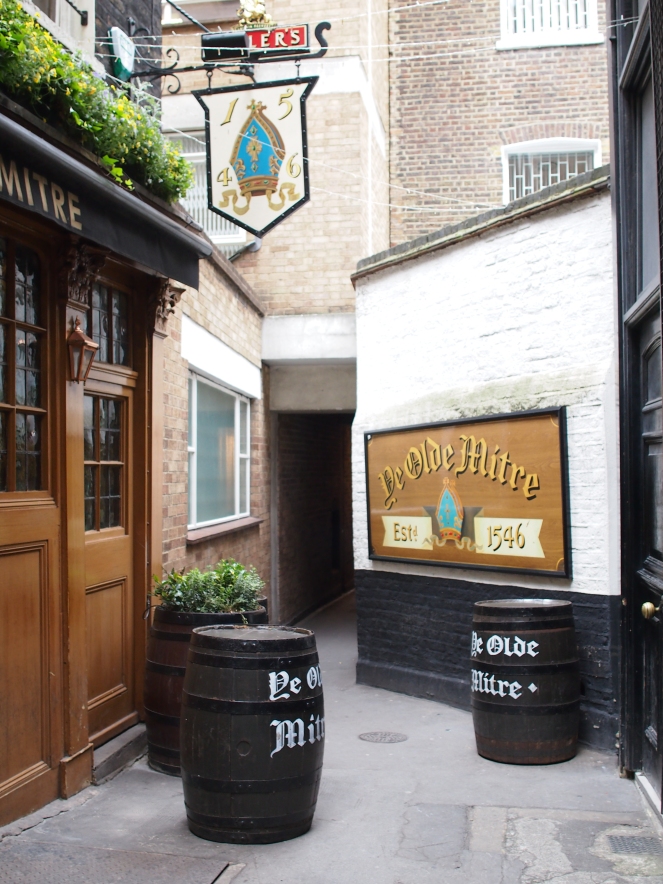
In 1772, the estate was sold to the Crown and the old palace, now in a ruinous state, was demolished.
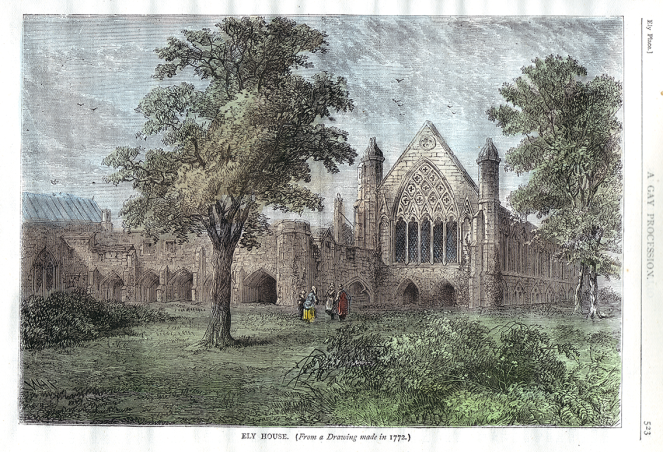
The handsome rows of townhouses that now stand on either side of the street were built in the same year.
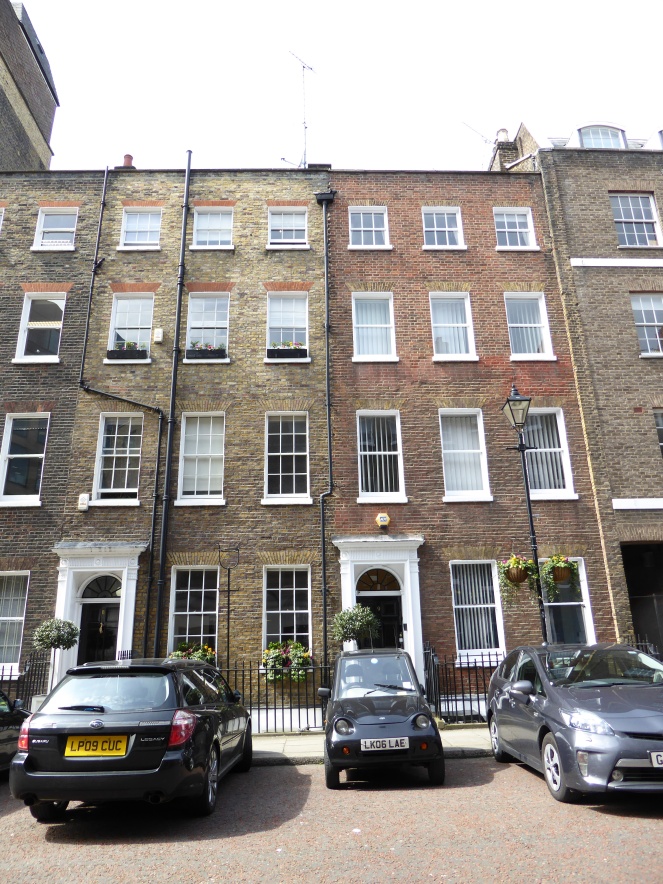
The chapel of St Etheldreda was for a time used as a school, before becoming the base of a Welsh-language church for a number of years in the 19th Century. The fabric of the building was deteriorating and it was in real need of restoration by the time that it was bought at auction by the Roman Catholic priest William Lockhart in 1873. Father Lockhart launched an appeal for funds and with this money the building was restored. During restoration, many of its medieval features were found to be intact behind later additions, including the stunning 13th Century roof.
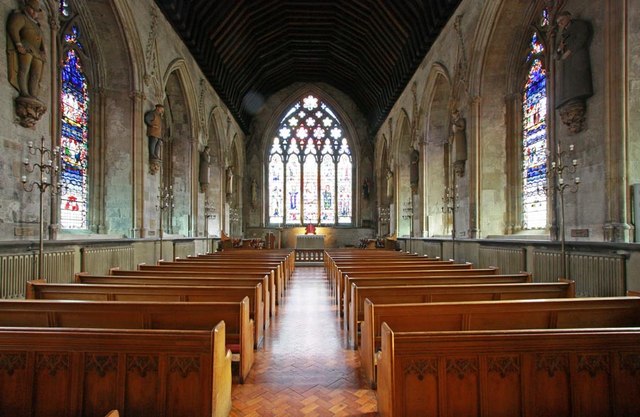
In 1878, the church’s restoration complete, mass was celebrated at St Etheldreda’s for the first time since the eve of the Reformation. A precious relic – the hand of St Etheldreda – had survived the destruction of the Reformation (when the shrine of St Etheldreda at Ely Cathedral had been destroyed) and was gifted to the newly-restored church at Ely Place.
Bombs dropped in air raids during the Second World War damaged a considerable amount of the church’s fabric, including its stained glass windows. These were replaced in the 1950s by the designs seen by visitors today. The church remains a popular venue for baptisms, weddings and other events, with the church’s spacious crypt often being utilised as a reception space.
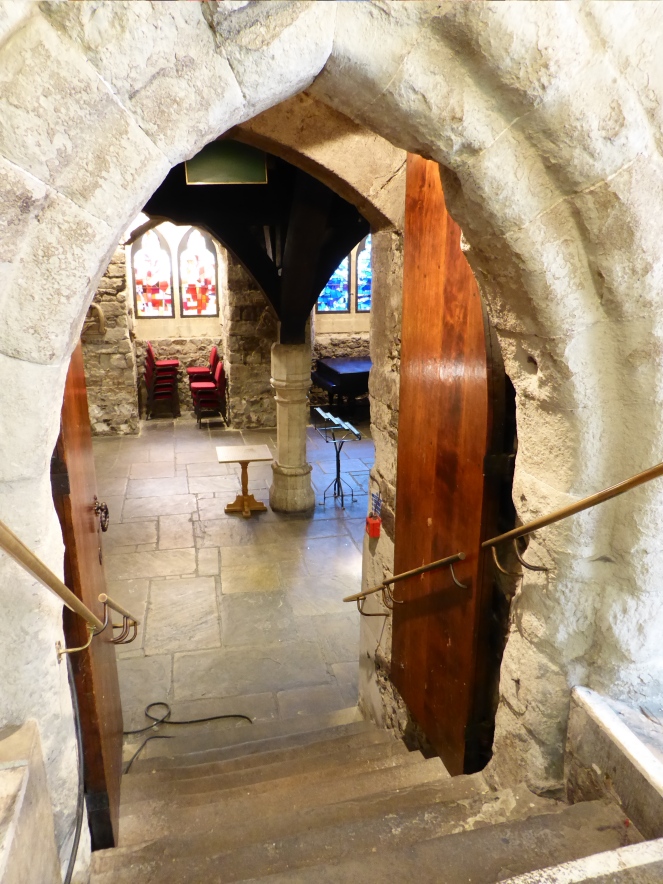
Although no longer the property of the Bishops of Ely (whose new London residence was established in Mayfair), Ely Place continued to be governed separately. In 1842 an Act of Parliament was issued to establish a group of commissioners responsible for the maintenance and security of Ely Place. Today, it is still a private street, with beadles guarding the entrance and barriers preventing unauthorised traffic from entering. Pedestrians can pass through, but are warned by a sign that they must abide by the rules of the Commissioners of Ely Place.
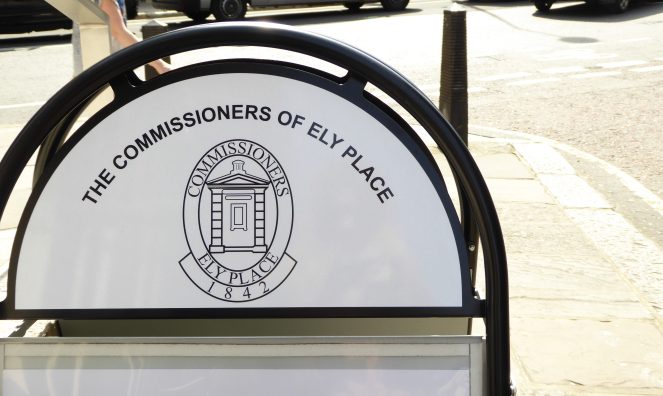
Ely Place, with its rich history and unusual governance, continues to attract interest to this day. Its status as a former part of Cambridgeshire often awards it a spot on the many walking tours that take place around that part of the city, and Ye Olde Mitre pub is a popular entry in lists of London’s “hidden” and historic pubs. Today its buildings are mostly occupied by prestigious legal firms, but its colourful array of former residents are still celebrated and its history has very much been kept alive.
References and further reading
Rev. Stephen Eyre Jarvis – A history of Ely Place: of its ancient sanctuary and of St. Etheldreda, its titular saint: a guide for visitors, St William’s Press, 1911 https://archive.org/details/historyofelyplac00jarv
Walter Thornbury, “Ely Place”, in Old and New London: Volume 2 (London, 1878), pp. 514-526. British History Online http://www.british-history.ac.uk/old-new-london/vol2/pp514-526
John Timbs – Curiosities of London: exhibiting the most rare and remarkable objects of interest in the metropolis; with nearly sixty years personal recollections, J C Hotten, London, 1867 https://archive.org/details/curiositiesoflon00timbiala
History of the Church – St Etheldreda’s Church http://www.stetheldreda.com/index.php/history-of-st-etheldredas/
Vitali Vitaliev – “Things that go bump on the map”, Daily Telegraph, 4th January 2003 http://www.telegraph.co.uk/travel/726471/Things-that-go-bump-on-the-map.html
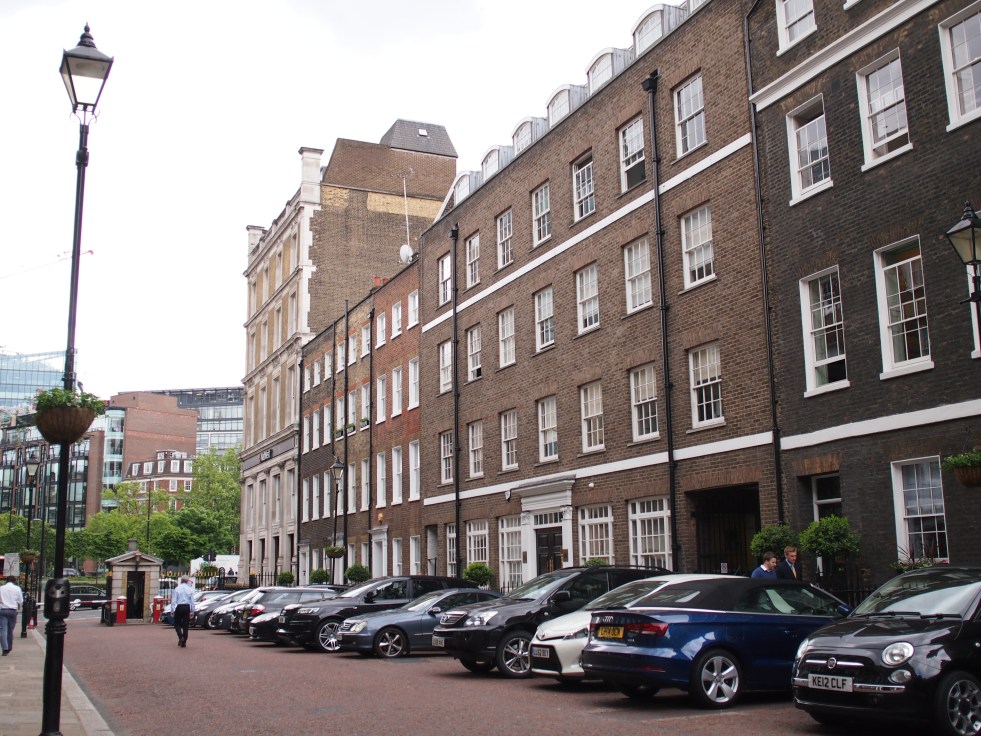

Fantastic post. Know a little about the place as we were regulars at the Mitre (just never moved the furniture away from the walls in the bar!). Wonder if Billy is still there, he was getting on a bit. The pub was used in the film – including ‘Lock, Stock and Two Smoking Barrels). Fascinating history that area and one of the many magical quirks on London. Love the photos too.
LikeLike
Very interesting place. It resembles a place I know on Sherbrooke Street in Montreal where Im from. Have a wonderful lunch. Bruce
LikeLike
Wonderful stuff. Have strolled around these places but will have to go back having read this. An influence on our second ever blog post!
LikeLike
I found this article very interesting as my 3rd Great Grandfather Henry Bean was one of the Beadles and he lived there in house No 4.. The 1851 and 1862 Census returns show him living there with his wife and daughter Emma. What surprises me was that no one else was recorded as living there. I thought at that time that several families would be living in these 4 story houses
I know several of the house including No 4 were knocked down when a new road was biult
LikeLike
Dear Caroline (if I may),
I have stumbled across your excellent and fascinating website while searching for an image of Ely Place for a conference paper. An eighteenth-century Quaker antiquarian, Thomas Ford Hill, lived at no. 30 in the 1780s, and a picture of the street would be nice to keep my audience awake… I’m unlikely to find my way to London in the near future, so would you be kind enough to give me permission to use one of yours, please? It would just be for the PowerPoint slides, and you would of course receive proper acknowledgement.
Many thanks and kind regards,
Anja.
LikeLike
Hi Anja,
Thanks for getting in touch – I’m happy for you to use a picture of Ely Place in your presentation, if you could credit it with Caroline Swan / flickeringlamps.com that would be super.
Hope your paper goes well!
LikeLike
Hallo,
I have an old philatelic item dated 1843 addressed to a Frederick Austin Esq, 6 Ely Place, Holborn. Have you come across this gentleman at all?
Kind regards
Alan Judge
LikeLike
Hi Alan,
I have not come across Frederick Austin, but as you know his address it may be possible to track him down via the 1841 or 1851 census – https://www.nationalarchives.gov.uk/help-with-your-research/research-guides/census-records/
Hope this helps, and sorry not to be able to help further.
LikeLike
Thanks very much Caroline.
LikeLike
Hi Alan, With regards to your query about a philatelic item dated 1843 addressed to a Frederick Austin Esq, 6 Ely Place, he is not related to me. My Great, Great ,Great Grandfather was Henry Bean and he lived at no 4 Ely Place with his wife and Daughter as recorded in the 1851 census. he was employed by the residents of Ely Place as Beadle and Gate Porter. I have a copy of his 1851 census return but only goes up to No 5 Ely Place. I know that Nos 1-6 were demolished to make way for a road. Id be interested to know what the Philatelic item is that you have and to know if it includes any information about Ely Place. I know from the 1841 census henry Was a gate Porter but not sure if he was living at Ely place, if he was he would have know Frederich Austin. Henry Bean was a Police Sergeant in the 1830’s one of the first peelers in London, so I guess that was what got him his position as beadle at Ely Place.
Regards
Alan
LikeLike
Hi another Alan,
Sadly, I have no additional information and the philatelic item was merely an envelope bearing an imperforate penny red stamp, but with a fine Maltese cross cancellation. It contained no letter. I try to write up every one of my postal stationery items and hereunder are my comments. The photo of Ely Place and the beadle’s post would not come across, but I assume you know what it looks like anyway. Your comment that 1-6 were demolished would explain why I could find no reference to Austin, although I surmised that he ‘wasn’t famous enough’. The information I have included came from various internet websites.
“Ely Place and the beadle’s post.
Ely Place stands on land that used to belong to the Bishops of Ely from 1290 to 1772, so we have a slight connection as the village of Ely and its beautiful church is just up the road from The Deepings. The most well-known of Ely Place’s inhabitants was John of Gaunt, Duke of Lancaster and son of King Edward III. John’s vast palace of Savoy on the banks of the Thames was burnt down during the Peasants’ Revolt in 1381, and after this event John moved to Ely Place and used the Bishops’ palace there as a residence for the rest of his life – he died there in 1399. He gets a mention in Shakespeare’s King Richard III,
“This royal throne of kings, this scepter’d isle – This Earth of majesty, this seat of Mars – This other Eden, demi-Paradis – This fortress built by Nature for herself – Against infection and the hand of war- This blessed plot, this Earth, this realm, this England.”
Thereafter the plot had several owners including James Butler, 9th Earl of Ormond and Sir Christopher Hatton who gave his name to Hatton Garden, just around the corner. The estate was sold to the Crown in 1772. Sadly, Frederick Austin Esq, was not famous enough to be listed in the local directory.
The stamp is of debatable quality. It is Plate 36, although the margins are closely cut, but the Maltese Cross cancellation is excellent. It was sent from Thayer Street to Holborn on 4 July 1843.”
LikeLike
Hi Alan, Many thanks for you informative reply. Pity no letter was included in the envelope. Is it possible to send me a copy of the envelope, I know he was not a relation to me but he was a neighbour of my Ancestor. When the new road was built one new building was built next to No 7 and they call it no. 1-6, its a Diamond Merrchants, I emailed them about No6 and they said they would make me cup of tea if I was ever in the area. Regards. ALAN
LikeLike
Alan, Yes, I can send you a couple of scans, but this site won’t let me paste them into this reply. If you let me have an email address I’ll send them that way.
LikeLike
Hi Alan, Many thanks for offering to send me copy of the envelope. My email address is *alanpatterson1947@gmail.com *
I had an unbelievable bit of luck when searching old Parish records for Shoreditch at a time when you had to through a copy of the book page by page. When I got to a page with details of Henry Bean I found an image of a letter on the facing page. which was written in his own hand to correct an incorrect birth record for one of his children. The letter showed he was a Police Sergeant at Finsbury in the 1830. From this and then finding he was a beadle at Ely Place it gave me a good idea of what life would have been like for him in the time of Charles Dickens. Some of Dickens characters were set in Ely Place with its Bleeding heart Yard and the old pub. From Dramas on TV I can imagine Henry walking the streets as an early Peeler and later as a beadle in Ely Place.
Hi son James my great great grandfather was a waiter in the Whittingham Club and later in 1866 he was the Cashier at the Langbourne Coffee House, I gather these Victorian coffee houses could be rather seedy places.
Regards Alan
On Fri, Nov 1, 2019 at 10:44 AM Flickering Lamps wrote:
> Alan Judge commented: “Alan, Yes, I can send you a couple of scans, but > this site won’t let me paste them into this reply. If you let me have an > email address I’ll send them that way.” >
LikeLike
Scans of the envelope now sent to your email address.
You’ve obviously done a lot of work on this. My family is traced with certainty to the early 19th century when it becomes a bit blurred with possible references to Ireland. However, my maternal side goes back to Tudor times and there are even links back to the days of Willy the Conk, although very disjointed and without confirmation of course. It’s all good fun and my family members now have copies of the family history to show my grand-children and great grand-children of which there are now three.
Good luck
LikeLike
Hello there. I also have an envelope addressed to a D. Boys esq 6 Ely Place London, dated 1861. Sadly I know nothing more than that at the moment.
LikeLike
Loved it round here. Worked at DTC 2 Charterhouse Street when Saffron Hill stairs was nearly opposite, Interested in the history of John of Gaunt and Katherine Swynford. Walked down to Bleeding Heart Yard many times. Your imagination can span the centuries from Plantagenet to Tudor etc.. It has changed since I was there in the late 1960s
LikeLike
I found my a couple of relatives in Ely Place in the mid 1800s and wonder if went downhil for a while. Bethnal Green seems to be the place for so many of my family and different branches of it too.
LikeLike
Hi fascinating history my wife’s grandmother lived at No22 in 1911 she was 5 what other sort of people lived there. She said it was a very poor area at that time? Rita
LikeLike